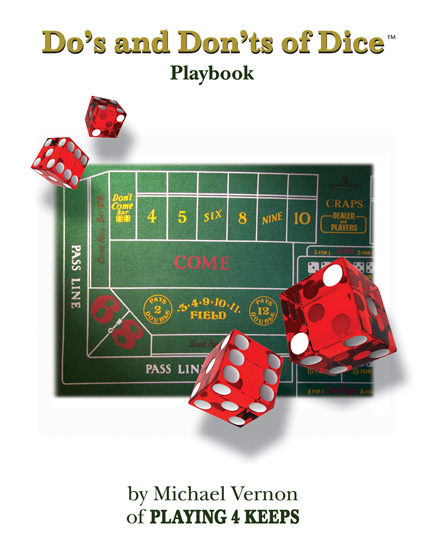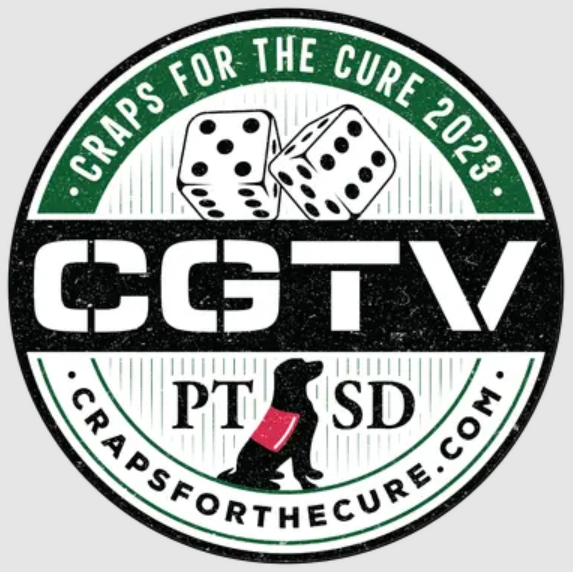|
Anatomy of Dice Setting...
BY: Michael Vernon
Dice control, dice setting, and dice influencing, to the novice crapshooter, these labels could appear synonymous. Although the terms have been loosely used and tossed about web sites and message boards to explain how a player can have an advantage in a dice game, the three terms do not define the same phenomena.
Dice control is a misnomer. Controlling the outcome of bouncing cubes as a preconceived notion by manipulation is utter nonsense. Anyone touting that ability is of course selling something.
Dice setting is simply taking the dice and prearranging them before shooting them. With two six sided cubes; there are over one thousand "different" ways of arranging the faces. There may be a thousand different opinions as to which arrangement is best.
Now, dice influencing is the most slippery of these tomato seeds. You see, as soon as you enter a game, as soon as you touch the dice, as soon as you have a thought about what you are about to do, you have created an influence.
I am not going into the metaphysical aspects here or the quantum physics. Just make a note regarding the influence of anything; it all begins with your intention as you impart your energy.
Most players take up dice manipulation with the idea of increasing their opportunity. However, they fail to focus on the subtleties of the art. That would be what I call the mechanical aspects necessary in order to develop consistent form. The mechanical aspects I refer to have to do with the shooters physical posture. It is all the movements involved with throwing the dice. As simple as it is, it is not so simple. First of all the practice time needed to develop consistent form is often ignored. Only by practice and careful self-observation does one hone the theory into a physical skill. Thus players with minimal exposure to dice setting go to casinos ill prepared.
If dice setting has a negative reputation, it is not so much the threat that it poses to casinos as is commonly thought. The treat to the game is the fumbling, bumbling, nervous and intimidated player slowing up the game. Gaming is big business and these days the accounting firm expects per hour results from every square inch of real estate in the casino, from the slot machines to the Big Wheel. When the afore mentioned player slows down the bottom line, of course the gaming managers are going to protect their investment and ask that player to adhere to house rules.
Casinos are not selling a product with your satisfaction guaranteed. A casino provides a privilege to those players wishing to gamble in games with odds guaranteed to separate those players from their money. It is the casino's game and it is played by their rules. Any notion to the contrary, that as a player, you get to complain or explain to the management what is fair or how you interpret the rules, is what the "pit bosses" laugh about on coffee break.
Practice arranging dice sets at home with a pair of casino dice. Train your eyes to see which die can be moved to make the set in the simplest way, verses having to arrange both dice. Train you eyes to recognize axis, faces and how random dice can usually be set quickly with minimal effort. You should not attempt setting dice in a live game until achieving confidence in your ability. How fast is fast when it comes to setting dice? 1-2-3, the dice are set, pick them up and shoot. In less than five seconds it is all over. Not only that, you will move the game faster than the shake-rattle and random roller. No one from the casino's side is going to bitch on you for setting dice if it is 1-2-3- pickup and shoot.
Once you have mastered arranging the dice, the mechanics of picking them up and the toss are the next steps. I am not going cover grips for picking up the dice. There are books and web sites covering this topic adequately. In short, the shooter decides on a grip that is comfortable and easy to use and of course works. http://www.dicecoach.com/dicegrips.asp
Understanding the complexity of the muscles and joints involved in tossing dice down the layout will greatly benefit your journey to becoming a skilled and consistent dice shooter. The shoulder joint, elbow joint, wrist joints and finger joints are all involved with the toss. It is in the fine-tuning of these joints, working anatomically, to have your dice flying through the air like matched swans in flight.
If you hope to have any association with the theory for dice setting, which is, keeping the dice on axis, land, hit the back wall on axis and rest on the same desired axis, the dice must start out and maintain that theorized axial position. In other words, you practice tossing dice until they look like mirror images while in flight and until they come to rest.
During your practice sessions, you critique and carefully observe the dice in flight, along with your anatomical movements. Just as any professional athlete practices hours to train for consistency, a dice setter must commit to the same discipline. It is similar to hitting a golf ball off the tee, serving in tennis, shooting from the foul line or pitching a baseball. Tossing dice, precision dice, requires the same hand-eye coordination. Only with practice and an open mind for improvement through change can a person hope to be any more than a random roller with random results.
These adjustments and changes for improvement are observed the movement you pick up the dice and all movements of your shoulder, arm, wrist and fingers. Subtle shifts in joint rotation greatly affect the flight of your dice. Release and follow through also contribute to the results. Keeping your focus on the landing spot is similar to free style archery. Look to the place where you want the dice to land. Dice trajectory, speed and rotational speed are other considerations as you develop your skill.
It is up to you how much time and scrutiny is to be invested in developing the skill. Dice setting adds another dimension to the fun and trill of the game. When it works it is a beautiful thing to experience. When it doesn't, well, at least you cannot be any worse off than random. Perfecting the skill, a player may experience .5% to perhaps 2% advantage over random tossed dice.
Once you understand and master the complexities in the art of shooting dice, adjusting to any table condition or shooting position is simply making the adjustment. You have already invested the time perfecting the tools.
Copyright (c) 2007 Michael Vernon
Click Here to return to the list of prior articles ...
|
 |










